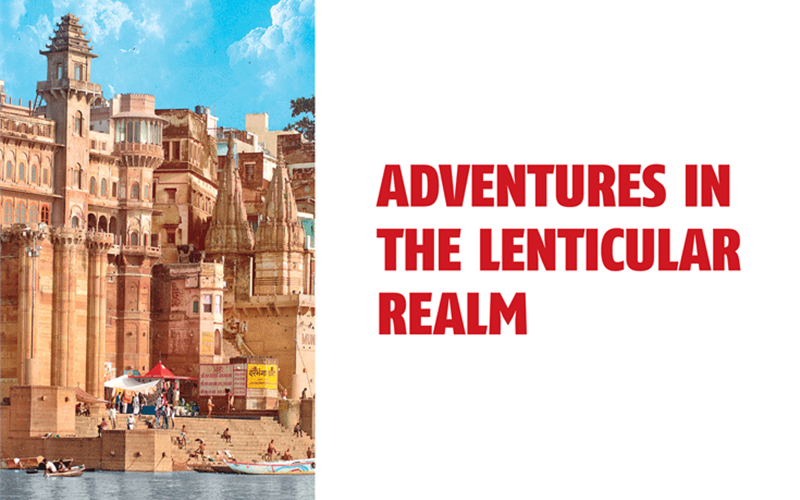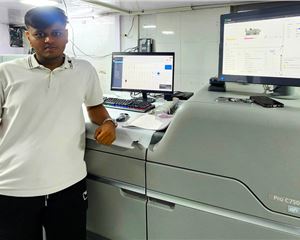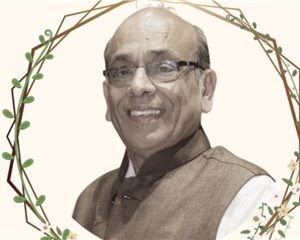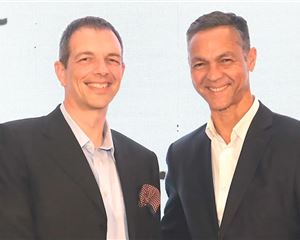Adventures in the lenticular realm - The Noel D'Cunha Sunday Column
Mumbai-based Taco Visions shows that it's urge to innovate remains undimmed.
The Sunday Column looks at Taco's Varanasi airport project which indicates how 3-D art is going to become part of the air traveller's ecosystem
17 Jan 2021 | By Noel D'Cunha
Prints displayed (includes signages) in public places like transit waiting areas, airports, commercial and retail locations, highways, walkways, buildings, medical treatment waiting areas and even on vehicles, are designed to attract our attention, an attempt to convey a message to the audience it is intended. While most use digital or screen printed graphics on vinyl, Mumbai’s Taco Visions uses the 3D lenticular technology, a kind of eye-catching animation or a 3D perspective on a picture.
Taco Visions was tasked to produce a unique piece of art for Varanasi’s Lal Bahadur Shastri International Airport, which would shape much of the aesthetic character of the city, and create a visual archaeology. The company used its expertise in lenticular imaging to produce a 21.5x8ft canvas.

The task
Varanasi is a sacred place with lots of spiritual and cultural influence, and now since under the vision and the leadership of Prime Minister Narendra Modi, the authorities are keen on making Uttar Pradesh a well-developed, modern and globalised centre in India.
The Ganga ghats bear an immense value and sanctity in hearts for all the Indians. It’s also a tourist destination. “Hence there is a wind of change which will change the identity of Uttar Pradesh of not just to remain a sacred place but a fast-growing cultural, global and the industrial hub of India,” says Taco’s head for research and development, Vinit Jadhav.
It was late March 2020, and the lockdown had just been announced, when the design was finalised. “But we had the inputs for the project to work on. The print industry was shut, but our chairman, TP Pandey and creative director, Mahesh Mahadkar were very keen to get the project going,” says Jadhav.
Keeping the main thread – the layered values and sanctity of the city, Mahadkar tried to highlight the main cultural colour along with its importance in the modern world in the 3D lenticular print medium.
From image selection to the 3D lenticular print and fabrication which includes its framing from the backside, its angles easy to mount, Taco pressed its decade-long experience into play, producing every aspect of the Varanasi airport project in-house, including a dry run of installation, in a period of 10 days. As lockdown eased, the Taco’s team was able to reach the airport site and replicate the installation of the printed images within three hours.

Pandey: Chairman, Taco Visions
A decade-long experience
To create a three-dimensional effect, layered images are converted into a number of views, which are then sliced depending on the size of the lenticular and then re-interlaced into one printable image format. This image is printed on paper with high precision, and then laminated on the lenticular sheet from the backside. This lenticular lens, when viewed with both our eyes, creates an illusion of three dimensional without the need of any other viewing device.
Taco deploys a Kodak Trendsetter CTP device, which is capable of producing 10-micron printing on a calibrated digital plate. The Kodak platesetter has a unique built-in feature called variable main scan resolution (VMR) which can produce the required dots for lenticular printing. A six-colour Heidelberg SM-72 printing press with coater and interdeck UV and IR dryer produce the 3D lenticular jobs.
Taco uses specially developed software, specially designed for 3D lenticular printing.
“At Taco we have been practising a perfect calibration system from pre-press to CTP and press to achieve the perfect dot on paper, which is the most important factor in lenticular printing. Secondly, the calculation of pitch for the lenticular sheet is rigorously followed to perfection. All this effort and dedication of the operators to achieve perfection, makes us stand above all our other competitors,” explains Jadhav.
For the Varanasi airport project, Taco printed the images using the Epson Stylus Pro 11880 printer.
There are a range of lenses which Taco sources for its 3D lenticular print work. “When you choose a lens it’s critical to consider the viewing distance, the angle of the lenticular, the lines per inch (LPI), the thickness, material and the printing method. “Client’s budget is as important,” says Mahadkar of Taco, who designed the project. “However, we consider all the factors and work accordingly to give our client the best he has thought of.”
As one of the pioneers in 3D lenticular works, Mahadkar said, each artwork Taco creates has its own uniqueness and identity. “We also incorporate our own experience and parameters on the subject to be implemented by the clients.”
And Taco has earned many awards and accolades for its work among them are: the largest animated 3D lenticular mural installed in Kokilaben Hospital in Mumbai has been noticed and mentioned in the Limca Book of Records; and the award for best 3D lenticular printing at Drupa 2012 in Dusseldorf. The company’s work was shortlisted during the Drupa 2016 awards contest.

Mahadkar: creative director at Taco Visions
The differentiation
Taco specialises in printing 3D lenticular photo-frames, standees, diaries, and calendars for religious shrines and temples. Some of its fast-moving devotional works are for Shri Gajanan Maharaj Temple in Shegaon, for Sai Shirdi Temple in Shirdi, Siddhivinayak in Mumbai, Tirupati Balaji Temple, and Swami Samarth Mutt among others.
Taco receives orders on a regular basis and all these job works run for the whole year.
Likewise, Taco also engages with many industries – from entertainment to infotainment, advertising to education, various government projects and also for many artists. However, each customer in these segments is different. “Their requirements and concepts are aimed at a particular audience,” says Mahadkar, as he explains, “For example, the advertising agencies, the government bodies, the spiritual gurus, individual freelancers like artists, painters ad gurus. These are different from one another. Hence we get a variety of exposure to work on new ideas and develop various concepts and to introduce novelty in it.”
Among its 3D lenticular works are the installation at Terminal 2 of Chhatrapati Shivaji Maharaj International Airport, a reproduction of the painting by renowned contemporary artist Baiju Parthan. Mahadkar adds, “We are working on 3D lenticular printing proposals to be installed at almost all the airports of India and possibly overseas too.”
For Taco, the customer is the king. It primarily focuses on the requirements of the clients and his expectations regarding his work to be implemented by us. “We have all the printing expertise and machinery set-up as well as technical know-how,” he says.
Pandemic and a tip on 3D lenticular
Like many, this pandemic wasn’t a particularly good time. Though meetings and discussions were taking place, Jadhav’s main worry was production, which was stopped due to lockdown.
“The lockdown gave us time to think on the Varanasi airport project, plan its production and implementation to perfection,” says Jadhav. “We had our limitations, financially. But we have overcome it by cutting our expenses.”
Coming back to 3D lenticular, Mahadkar shares a tip about 3D and lenticular. According to him, the lenticular medium is not just a technical method. One has to use the method intelligently to achieve the desired end result. “Here we need to calibrate the machinery accordingly and keenly inspect the minute details of an image to eliminate small mistakes which can be disastrous, considering lenses don’t come cheap,” concludes Mahadkar.












 See All
See All